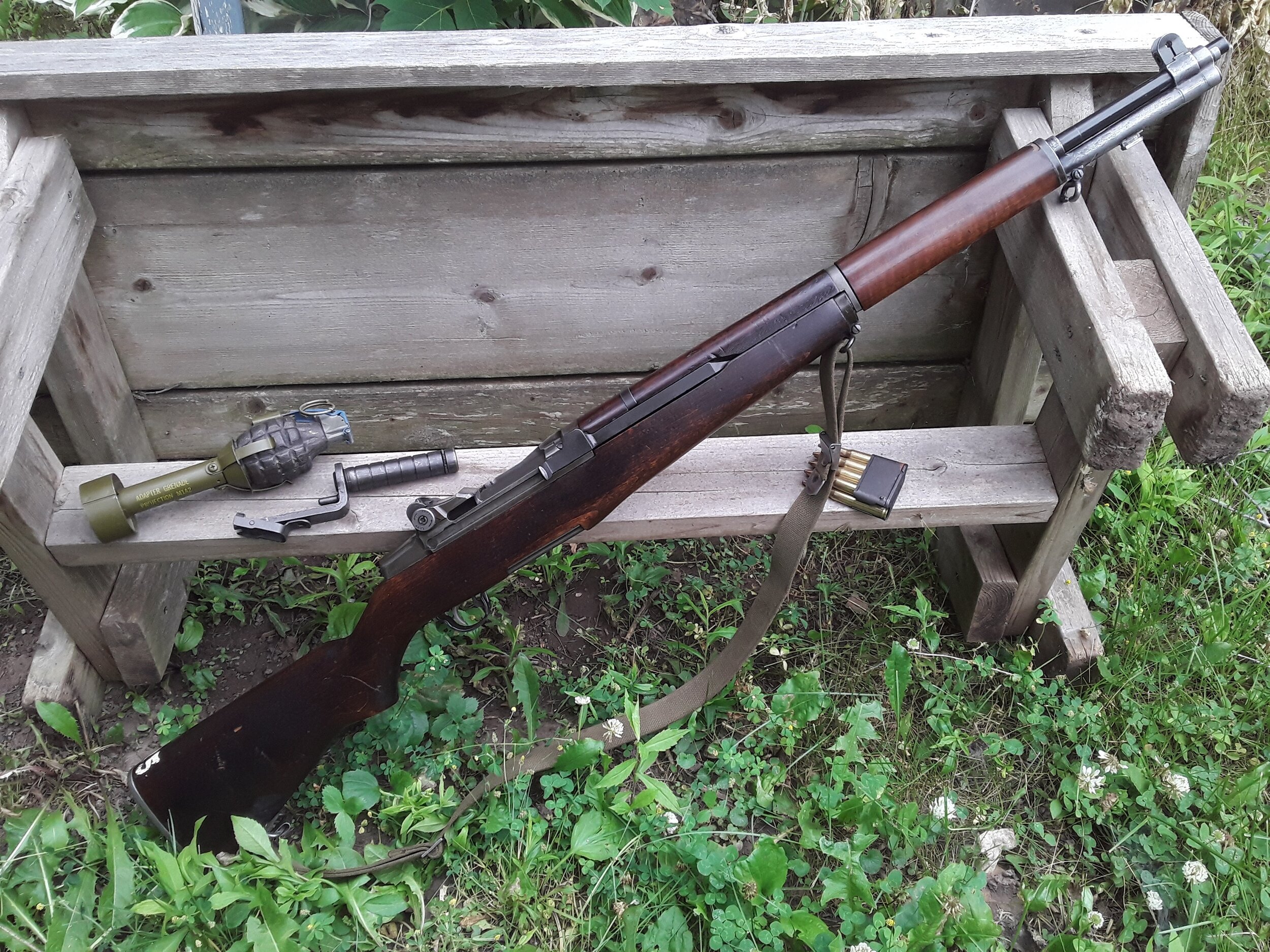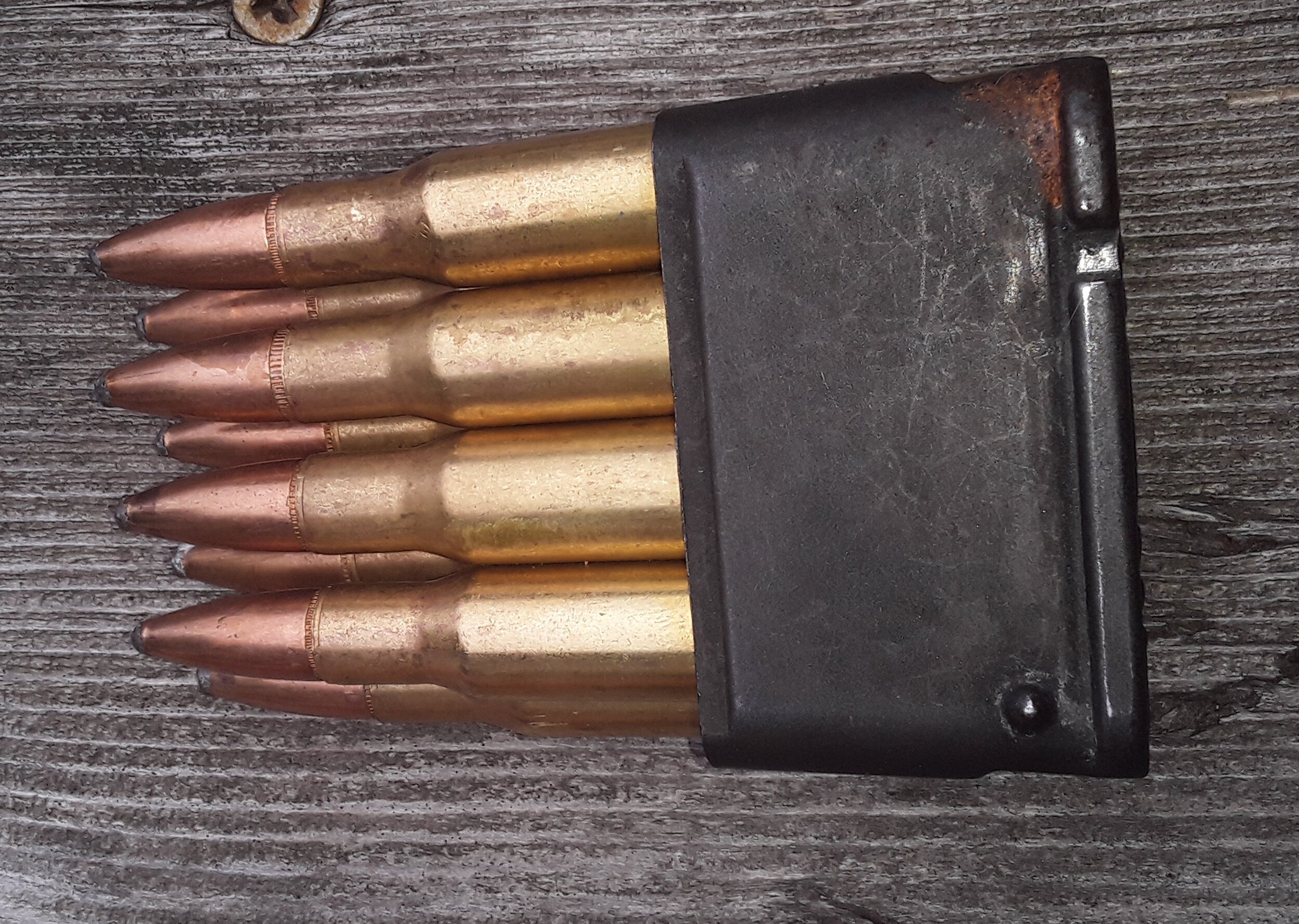M1 Garand
Perhaps the most iconic firearm of the Second World War, the US Rifle, Caliber .30 M1 was the primary weapon of American GIs across the world
The History
In the interwar years the United States was looking to replace the M1903 Springfield bolt action rifle with a semi-automatic design as the standard infantry weapon of its armed forces. In this they were not alone, as most other major powers were exploring the concept as well, particularly as another World War loomed. The resulting trials, over several years, eventually came down to a contest between a toggle-locked design by Pedersen and the gas trap long stroke piston design submitted by Canadian born John Garand, both in a new .276 caliber cartridge.
The action of the M1 Rifle, showing the rotating bolt with its dual locking lugs, as well as the National Match charging handle on this example
As the trials continued in the early 1930s the .276 cartridge was droppped, due to the concerns of top Army officials regarding the expense of conversion as well as the vast stocks of .30-06 ammunition stockpiled. The result was that the Garand, originally designed in the .30 caliber cartridge was reverted, and the Pedersen rifle, which required wax coated cartridges to ensure proper function, was dropped. The Garand rifle was thus officially designated as the “US Rifle, Caliber .30, M1”, and officially adopted in early 1937.
The action open, revealing the complex internal magazine of the M1 Garand. The entire mechanism was powered via the same spring that drove the operating rod
Despite this adoption, problems persisted with the new rifle, which eventually led to a redesign of the gas system that operated the rifle. The result was the elimination of the gas trap design (a trap near the muzzle that captured muzzle force and used that to cycle the action) and its replacement with a conventional gas port, although the long operating rod was retained, with the port and gas block just behind the muzzle. The rifle was in full production at Springfield Armory by the outbreak of war in 1939, and the US Army was almost entirely reequipped with the M1 by mid 1941.
The action with a loaded en-bloc clip inserted, note the feed lips provided by the clip and the double-stacked cartridges
Production was also started in 1940 at Winchester to increase the supply rate as the international situation declined, but when the United States was thrust into the conflict on December 7, 1941 not all troops could had been issued the new rifle. The bulk of the US Marine Corps that was to take the imitative in the Pacific was still equipped with the older M1903, and forces in far flung US possessions, such as the Philippines, found themselves on the frontlines with an assortment of older weapons. This would, however, be quickly rectified as production ramped up for the war, and by the end more than 4 million rifles had been produced.
An en-bloc clip loaded with modern, soft point .30-06 ammunition. The clips themselves were made of stamped steel, and considered disposable
The M1 saw service on all fronts involving US troops, and would also be supplied to allied forces in various quantities during the war. It generally acquired a solid reputation as a dependable weapon, and as the only fully standardized semi-automatic service rife during the war, the M1 provided American GIs with a substantial force multiplier over the bolt action designs of the Axis Powers. The M1 would again see service in Korea, with production resumed and the addition of civilian manufacturers Harrington and Richardson and International Harvester into the mix. The M1 would eventually be replaced by the improved M14 in 1958, although some remained in service at least through the 1960s, and Cold War allies such as the Republic of Vietnam continued their use long afterward. The rifle remains in use to this day with various ceremonial and drill units in the US and beyond, and is a common sight in the hands of veteran’s organizations such as the American Legion for ceremonial duties. Surplus M1s remain available to US citizens directly from the government via the Civilian Marksmanship Program.
The latch on the side of the receiver is used to release a partially loaded clip from the rifle to facilitate unloading of the weapon
The Design
The M1 Garand uses a long stroke gas piston connected to the bolt via the charging handle, and notable only uses a single spring to actuate both the operating rod (piston) and the magazine. A complex mechanism using an arm connected to the mainspring drives the follower of the magazine up to feed cartridges. The rifle is loaded with .30-06 M2 Ball ammunition with stamped steel en-bloc clips containing eight cartridges in two staggered columns of four rounds, and the empty clip is ejected from the action with the last casing with a distinctive “ping” sound. A myth exists regarding the ability of the enemy to hear this ping and locate the shooter, but in the din of battle and following the blast of the .30-06 cartridge this is unlikely and redundant. Another quirk of the design is in its loading: when the follower is depressed the bolt is released, thus it is reccommended by even the US Army to load the rifle with the thumb while the rest of the fingers lie on the side of the receiver and against the charging handle, preventing an uncomfortable occurrence known colloquially as “M1 Thumb”, getting one’s finger caught by the spring loaded bolt.
The safety of the M1 is located within the trigger guard, and is pushed forward to disengage (shown in the engaged position)
The M1 features excellent sights, with a rear aperture that is adjustable for windage and elevation, combined with a singed square post front sight. This combination is a far superior option to the Buffington sights found on the M1903, which, while also designed for marksmanship, sacrificed on effectiveness in some combat situations and were also rather fragile.
The rear sight of the M1 rifle. The knob closest to the camera is for elevation, while the opposite side is for windage.
The rifle could accept the same M1905 bayonet as the earlier M1903 rifle, as well as the even older Krag series (although these were long out of service by the arrival of the Garand). A rifle grenade launcher was also developed, the M7, which was a spigot type that attached to the muzzle via the bayonet lug. This permitted the firing of a rifle grenade with a blank, and the delicate operating rod was protected via a spring-loaded valve in the gas plug that was closed by a stud on the launcher.
The front sight of the M1, mounted to the gas block near the muzzle. The gas port is on the bottom of the barrel directly beneath the sight
The rifle was issued with a cleaning kit that was stored in a compartment within the buttstock, consisting of an oiler, takedown tool, brush and cleaning rod. Slings were originally leather M1907 slings carried over from the M1903 rifle, but in the late states of the Second World War and beyond these were replaced with simplified canvas slings.
The markings located on the rear of the receiver, with model designation, caliber, manufacturer, and serial number
Sniper versions of the M1 also existed, with the M1C seeing limited service late in the Second World War, fitted with a side mounted 2.2x Lyman scope and a leather cheek pad, as well as a flash hider. The M1D was the same but used a different mount for its scope. These proved relatively unpopular, as the side mounted scope, necessary due to the en-bloc loading, made for an awkward rifle to use.
The M7 Rifle grenade Launcher, shown with and without a dummy grenade attached
This Example
The example in the author’s collection was produced by Springfield Armory in November of 1943, and like many M1 rifles has seen numerous rebuilds by US Government arsenals over its lifetime. It features mostly late components, such as the sights and a 1950s vintage Springfield barrel, along with a national match operating rod. it previously belonged to the author’s father, and before that his grandfather, a US Marine Corps veteran of the Korean War.
The author’s grandfather, Gerald Gurske, armed with an M1 Garand during the Korean War
Opinions
The M1 Garand is one of the most iconic small arms of all time, rightly remembered as the faithful companion of the American GI in the deserts of Africa, bocage of Normandy, jungles of the South Pacific and frozen banks of the Chosin Resevoir among so many others. The M1 was the only semi-automatic rifle to achieve full standardization during the Second World War, providing a notable advantage in firepower to the American soldier over his counterparts, both friend and foe. That said, it is not a rifle without flaws.
The most glaring issue is that it is a complicated weapon. Basic field strip includes the disassembly of the entire magazine, with several small parts and non-captive pins that could present a problem under field conditions. The long operating rod is fairly delicate and one must exercise some care in the choice of ammunition to prevent bending it (albeit this was not an issue in military service, as it was designed to handle service loads without issue). The rifle is also fairly heavy, and a thick stock, although strong, results in the rifle trending towards the cumbersome side of things. The en-bloc loading also leaves something to be desired, opening a large section of the action to debris and making “topping off” awkward.
On a more positive note, the M1 is extremely accurate, being to this day a favorite for match use, with excellent sights that allowed the US infantryman of the time to take full advantage of his training as a marksman. The weapon was also reliable in adverse conditions, serving the GIs around the world and earning a strong reputation that holds through generations to today’s collectors and shooters. Despite the issues of the en-bloc system, in practiced hands it mated well to the semi-automatic mechanism to allow for unparalleled rate of fire.
I would personally rate the M1 as the best standard issue infantry rifle of the Second World War, and a solid addition to any collection today. These rifles are still available at reasonable rates from the US Civilian Marksmanship Program, and I highly recommend them to anyone interested in shooting sports, historical collecting, or simply interested in owning an iconic piece of American history.
Two US Army riflemen fire on Japanese troops with the M1s during the Battle of Okinawa. Note also the man in the foreground carries a US M1911 pistol as well as a captured Japanese Type 14 Nambu
Observed Values and Frequency
Updated: February, 2024
AVERAGE VALUE (USD): $750 - $1,500
FREQUENCY: Common
COLLECTOR’S NOTES: Despite frequency, M1 Garand rifles are in high demand and command high prices outside of direct orders from the CMP













